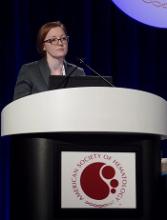SAN DIEGO—An algorithm has proven effective for identifying differentiation syndrome (DS) in patients taking ivosidenib or enasidenib, according to a speaker at the 2018 ASH Annual Meeting.
The U.S. Food and Drug Administration (FDA) recently announced that DS is going unnoticed in some patients with acute myeloid leukemia (AML) who are taking the IDH2 inhibitor enasidenib (Idhifa) or the IDH1 inhibitor ivosidenib (Tibsovo).
Though both drug labels include boxed warnings detailing the risk of DS, the FDA found evidence to suggest that DS is underdiagnosed, which can result in fatalities.
The FDA performed a systematic analysis of DS in AML patients taking either drug to determine if an algorithm could uncover a higher incidence of DS than was previously reported.
Kelly J. Norsworthy, MD, of the FDA, described the results of this analysis at ASH as abstract 288.
The analysis included patients with relapsed/refractory AML treated on a phase 1 study of ivosidenib (NCT02074839, AG120-C-001) and a phase 1/2 study of enasidenib (NCT01915498, AG221-C-001).
There were 179 patients treated with the approved dose of ivosidenib and 214 treated with the approved dose of enasidenib.
The researchers searched for DS events in the first 90 days of therapy. Patients were categorized as having DS if they had at least one investigator-reported DS event (IDH DS or retinoic acid syndrome) or if they had at least two signs or symptoms of DS, according to revised Montesinos criteria, within 7 days.
The signs/symptoms included:
- Dyspnea
- Unexplained fever
- Weight gain
- Unexplained hypotension
- Acute renal failure
- Pulmonary infiltrates or pleuropericardial effusion
- Multiple organ dysfunction.
“We added an event for multiple organ dysfunction since this adverse event could satisfy multiple Montesinos criteria,” Dr. Norsworthy said.
“Although leukocytosis is not a diagnostic criterion for DS, it is frequently seen in association with DS, so we performed an additional query for concomitant leukocytosis,” she added.
The researchers looked for adverse events of leukocytosis, hyperleukocytosis, white blood cell count increase, and leukocyte count greater than 10 Gi/L within 7 days of clinical signs/symptoms.
DS incidence
The algorithm suggested 40% of patients in each treatment group had potential DS—72 of 179 patients treated with ivosidenib and 86 of 214 patients treated with enasidenib.
“We reviewed case narratives and laboratory data from the algorithmically defined cases of DS to adjudicate whether cases were DS or unlikely DS due to an alternative explanation, most commonly due to a clinical course inconsistent with DS or confirmed infection,” Dr. Norsworthy said.
The reviewer-adjudicated incidence of DS was 19% in both groups—34 patients on ivosidenib and 41 patients on enasidenib.
“This contrasts with the DS incidence of 11% to 14% reported by investigators,” Dr. Norsworthy said. “Thus, there was a subset of patients where the syndrome was not recognized by investigators.”
Characteristics of DS
The median time to DS onset in this analysis was 20 days (range, 1 to 78) in the ivosidenib group and 19 days in the enasidenib group (range, 1 to 86).
In both treatment groups, most patients had moderate DS—71% (n=24) in the ivosidenib group and 80% (n=33) in the enasidenib group. Moderate DS was defined as meeting two to three of the aforementioned criteria for DS.
Fewer patients had severe DS (four or more criteria)—24% (n=8) in the ivosidenib group and 12% (n=5) in the enasidenib group.
For the remaining patients, DS severity could not be determined—6% (n=2) in the ivosidenib group and 10% (n=4) in the enasidenib group. These were investigator-reported cases of DS.
Most DS cases in the ivosidenib and enasidenib groups—68% (n=23) and 66% (n=27), respectively— included grade 3 or higher adverse reactions.
Two patients in each group died of DS—6% and 5%, respectively. Only one of these cases was recognized as DS and treated with steroids, Dr. Norsworthy noted.
She also pointed out that most patients with DS had leukocytosis—79% (n=27) in the ivosidenib group and 61% (n=25) in the enasidenib group.
In addition, rates of complete response (CR) and CR with incomplete hematologic recovery (CRh) were numerically lower among patients with DS, although the confidence intervals (CI) overlap.
Among patients on ivosidenib, the CR/CRh rate was 18% (95% CI, 7-35) in those with DS and 36% (95% CI, 28-45) in those without DS.
Among patients on enasidenib, the CR/CRh rate was 18% (95% CI, 7-33) in those with DS and 25% (95% CI, 18-32) in those without DS.
“[F]irm conclusions regarding the impact on response cannot be inferred based on this post-hoc subgroup analysis,” Dr. Norsworthy stressed.
Predicting DS
Dr. Norsworthy noted that baseline patient and disease characteristics were similar between patients with and without DS.
The researchers did see a trend toward higher blasts in the marrow and peripheral blood as well as higher white blood cell counts at baseline among patients with DS.
“However, there did not appear to be a distinct baseline white blood cell count or absolute blast cell count cutoff above which DS was more common,” Dr. Norsworthy said.
She added that the patient numbers are small, so it’s not possible to make firm conclusions about prognostic factors for DS.
In closing, Dr. Norsworthy said the algorithmic approach used here “led to the recognition of additional cases of DS not identified by investigators or review committee determination for patients treated with the IDH inhibitors ivo and ena.”
“Increased recognition of the signs and symptoms of DS through the framework of the Montesinos criteria may lead to early diagnosis and treatment, which may decrease severe complications and mortality. Furthermore, integration of the algorithm into clinical trials of differentiating therapies, in a prospective fashion, may help to systematically monitor the incidence and severity of DS.”
Dr. Norsworthy declared no conflicts of interest.


